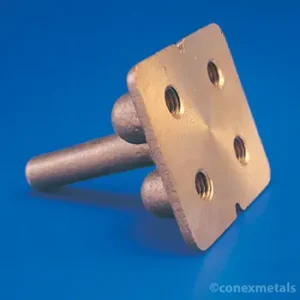Terminal Bases
Terminal Bases
| Terminal Bases | |||
|---|---|---|---|
| Thread Dia mm | Conductor Size mm | Material | Weight kg |
| 16 | 25 | Copper | 0.5 |
| 16 | 25 | Aluminium | 0.17 |
| 10 | 8 or 25 x 3 | Aluminium | 0.15 |
| 16 | 31 x 6 | Copper | 0.5 |
| 16 | 50mm² | Copper | 0.8 |
| 16 | 70mm² | Copper | 0.75 |
| 16 | 95mm² | Copper | 0.9 |
 Terminal bases, also known as terminal blocks or wiring bases, are modular devices used in electrical and electronic applications to facilitate the connection and termination of electrical conductors. They serve as a central point for joining multiple wires or cables, allowing for easy and organized electrical connections in various systems.
Terminal bases, also known as terminal blocks or wiring bases, are modular devices used in electrical and electronic applications to facilitate the connection and termination of electrical conductors. They serve as a central point for joining multiple wires or cables, allowing for easy and organized electrical connections in various systems.
Key features and uses of terminal bases include:
- Connection Points: Terminal bases consist of a series of metal or insulated terminals arranged in a row or a block. Each terminal provides a connection point where wires or conductors can be securely attached.
- Wire Termination: Wires are typically terminated onto the terminals using screws, spring clamps, or other methods, depending on the design of the terminal base. The termination method ensures a reliable electrical connection.
- Modular Design: Terminal bases often have a modular design, allowing them to be easily snapped together or mounted side by side to create larger connection points for multiple wires.
- Labelling: Some terminal bases have areas for labelling or marking the connected wires, making it easier to identify and trace connections.
- Types: Terminal bases come in various types, including barrier terminal blocks, feed-through terminal blocks, fuse terminal blocks, and ground terminal blocks, among others. Each type is designed for specific applications and connection requirements.
- Applications: Terminal bases are widely used in industrial control panels, electrical cabinets, power distribution systems, motor control centers, electronics prototyping, and various other applications that involve electrical connections.
Terminal bases play a crucial role in electrical wiring and control systems, providing a safe and organized way to manage electrical connections. They simplify maintenance and troubleshooting tasks, as they allow for easy disconnection and reconnection of wires without damaging the conductors.
It is essential to choose the appropriate terminal base based on the specific requirements of the electrical or electronic system. Factors to consider include the type of conductors (solid or stranded wires), current-carrying capacity, voltage rating, and environmental conditions (temperature, moisture, etc.).





